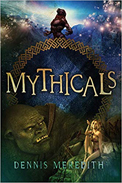
 |
On Thera, a planet similar to Earth, a senator’s brief encounter with an overzealous, albeit drunk and newly laid-off reporter, Jack March, exposes an age-old secret: fantastical, alien species that were only talked about as legends not only existed but lived in unison with the human population. From werewolves, ogres, and trolls to vampires, enchanting pixies, and fairies, the gamut of species can be found in this narrative. Perhaps the most intriguing aspect of Meredith’s work, in fact, is how he has produced a text that can be classified as the intersection of science fiction and fantasy. While combining the two genres is generally difficult, Meredith uses rich worldbuilding and endearing characters to make the fusion of the two genres a seamless process.
The discrete nature of mythicals, a group of alien species, is put to the test when March continues to prod, refusing to believe that the winged fairy he saw shedding her human skin and flying into the night during the honorary party was simply a figment of his imagination. One by one, the different species begin to build a relationship with March, who falls for the seductive charms of one in particular: Sam the pixie. Though there is such a wide range of characters and species in the novel, what makes audiences gravitate to them is their humanistic qualities. They are flawed characters, some with powers to destroy and others with supernatural strength that serves to protect.
While the main characters—March, Sam, and the fairies A’eiio and E’iouy—certainly dictate the plotline of the novel, Meredith does a commendable job of integrating more minor characters and providing them with a role that is still central to the novel’s main objective. Specifically, the comical, bar-frequenting nature of Vladimir the vampire and the temperamental and domineering werewolf, Flacktuckmetang, stand out throughout the novel.
When the mythicals, who were originally banished from their home planet for a variety of relatively minor crimes, are brought out in the open, the pace reaches a breakneck speed, and readers become privy to a multitude of agendas from all parties involved. Within this context, Meredith also provides an astute and thorough establishment of science fiction fundamentals, from a coma-inducing microchip planted into all organisms (and controlled by the Wardens) to wormholes that open up to alien planets. For example, one of the wormholes leads to the mythicals’ native planet, where everything appears picturesque, and crystal spires graze the sky with seemingly no end.
The thread that unifies the elements of fantasy and science fiction in this narrative is the mythicals’ purpose. Concepts of environmental preservation and the inevitable destruction of the planet are central to their purpose, but to what degree their intentions are noble is up for debate. Nevertheless, the method in which Meredith brings this issue to light raises many questions for our own society. For instance, at what point will those at the forefront of government and authority deem that our planet is headed down a hazardous and potentially destructive path? As is the case with mythicals, who has the power to dictate the terms of this prospective cleansing? Or is it simply the person with the most power—a resonating theme of how the strong survive while the weak perish? On a greater, philosophical level, the author’s work can even be interpreted to demonstrate mankind’s divisive nature and need for conformity. For millennia, mythicals wearing flesh suits lived perfectly human lives, contributed to society as much if not more than their peers, and even gained positions of political power. Why then would humans immediately perceive this species as a threat because of their altered appearance? Overall, the nonstop, ever-evolving plotline, relatable characters, and a glimpse into how science fiction and fantasy can merge successfully make this book a must-read.
RECOMMENDED by the US Review